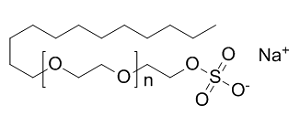Sodium Lauryl Ether Sulfate

Product Description
Sodium lauryl ether sulfate (SLES), an anionic surfactant, is widely used in various industrial applications due to its excellent foaming and cleansing properties.
Product:
Sodium Lauryl Ether Sulfate
CAS:
68891-38-3
Synonym:
Sodium alkylethersulfate; Lauryl alcohol, ethoxylated & sulfated, sodium salt; Lauryl ether sulfate, sodium salt
Structure:

Typical Characteristics
Appearance
Clear to slightly yellowish viscous liquid
Boiling point
400 °C
Density
1.08 g/cm3
Molecular Weight
280-300
Odor
Odorless
Purity
99%
Refractive index
1.464
Uses, Applications & Markets
Key applications
get a quote
We Offer Sodium Lauryl Ether Sulfate
in various grades
A few of the grades available are listed below:



Sodium Lauryl Ether Sulfate used in many
industry applications
Sodium lauryl ether sulfate (SLES), an anionic surfactant, is widely used in various industrial applications due to its excellent foaming and cleansing properties. Here are some of its industrial uses:
- Personal Care Products: SLES is a key ingredient in many personal care products, including shampoos, body washes, and facial cleansers, where it acts as a foaming agent and emulsifier. Its ability to create a rich lather makes it popular in cleansing formulations.
- Detergents and Cleaners: It is extensively used in household and industrial detergents, laundry powders, and dishwashing liquids due to its strong cleaning power and ability to remove dirt, grease, and stains effectively.
- Industrial Cleaning: SLES is employed in various industrial cleaning applications, such as car wash formulations, degreasers, and floor cleaners, where its excellent detergency and foaming properties are utilized to achieve thorough cleaning results.
- Textile Industry: In textile processing, SLES is used as a wetting agent and detergent in the preparation and scouring of fibers and fabrics. It helps to remove impurities, oils, and waxes from the textile materials, preparing them for further processing and dyeing.
- Emulsion Polymerization: SLES serves as a stabilizing agent in the emulsion polymerization of synthetic polymers, such as latex paints, adhesives, and coatings. It helps to disperse and stabilize the polymer particles in the aqueous medium, resulting in uniform and stable emulsions.
- Firefighting Foams: It is used in the formulation of firefighting foams, especially in aqueous film-forming foams (AFFF), due to its ability to produce stable and long-lasting foam blankets. These foams are effective in extinguishing flammable liquid fires.
- Agrochemicals: SLES is utilized in the formulation of agricultural adjuvants and pesticide formulations to improve spreading, wetting, and penetration properties. It helps to enhance the effectiveness and coverage of agricultural sprays.
- Oil and Gas Industry: In the oil and gas industry, SLES is used as a foaming agent in drilling muds and well stimulation fluids to improve fluid properties, aid in the removal of cuttings, and enhance borehole stability during drilling operations.
- Food Industry: While not as common as in other sectors, SLES is occasionally used in the food industry as a foaming agent and emulsifier in food processing applications, such as cleaning of food processing equipment and dairy processing.